Sassuolo had been one of the most entertaining teams to watch over the last few years under Roberto De Zerbi, and their displays have been a pleasant surprise in the tactical world. That’s why it was interesting to see whether or not the club’s new coach, Alessio Dionisi, could continue the tradition and even improve their tactics and performance.
The 41-year-old came to Sassuolo after a successful promotion-winning season with Empoli and immediately showed his tactical vision, despite the rough start at his new job. While the team couldn’t show consistency, their identity was peeking through and quickly made it clear that they have the ability to trouble their opponents with their intriguing build-up strategies and actions in possession. At first, Dionisi’s strategy of building up from the back was difficult to implement due to the team’s inability to sustain pressure and beat the opposition’s pressing structures. At the end of the year, things look better for I Neroverdi, as they gain more confidence and develop a better understanding of the manager’s requirements.
It is their defensive performance, though, that keeps them away from getting the full respect of their opponents and makes them vulnerable, often throwing their attacking efforts to waste. That’s also the reason for their continuing inconsistency in terms of the end product, as they currently have won six games, drawn five and lost six — certainly not a satisfying record for a team as intriguing as Sassuolo.
In this tactical analysis, we examine Dionisi’s tactics and provide a full picture of what can be expected by the young Italian coach in the future.
Main traits and structure
Dionisi tactics didn’t change much about Sassuolo’s set-up as it was working well to retain possession and build up with high pass frequency, which is key in his tactics. The 4-2-3-1 is still their most-used formation, although he makes some tweaks depending on the opposition and occasionally opts for 4-3-3 or 4-1-4-1 if he would like to employ a more aggressive attacking approach with more direct players in front of the goal.
The team try to keep their compactness and be well-structured in possession in order to implement their possession football. They aim to use high pass frequency and a lot of movement to bypass the opposition press and progress the ball.
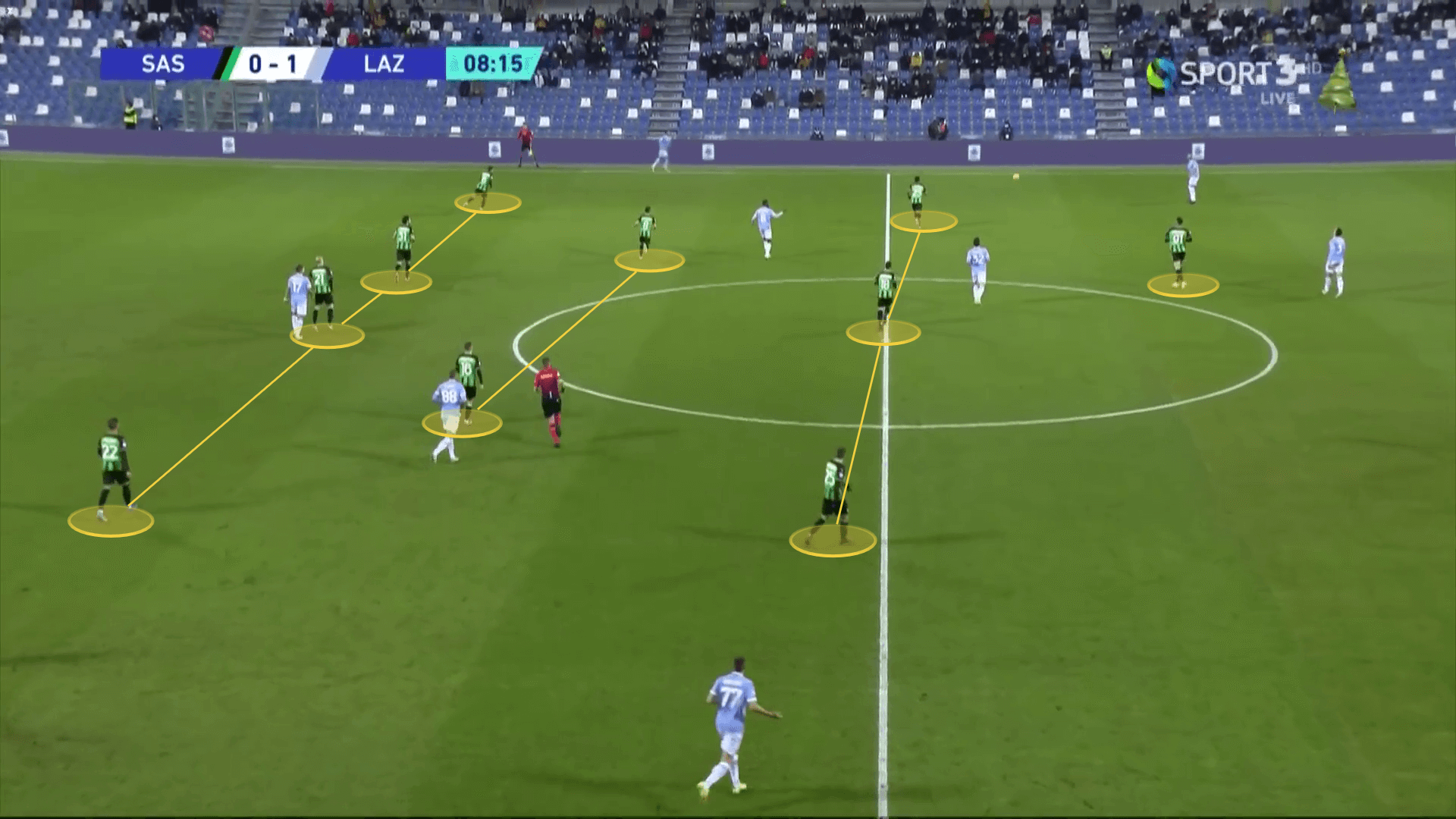
The team rely on a balanced approach and do not overcommit to certain areas, but instead use all channels to attack and create chances.
They usually tend to stay deeper and invite the play to their own half, which occasionally results in having difficulties breaking through the opposition defences. Their lower positioning gives their opponents a better chance of dropping back defensively and structuring well, which often forces Sassuolo to shoot from distance.
The team struggle when the opposition use a lot of movement and link-up-play and manage to break their structure and compactness.
Ball progression and actions in possession
The build-up-play is the most recognisable part of Sassuolo’s playing style. The team’s efforts start from the back as they often involve the goalkeeper in ball retention, although it is most frequently circulated between the centre-backs and one of the centre midfielders.
Gian Marco Ferrari is Dionisi’s choice for the left-centre back position, while he doesn’t have a consistent RCB and usually relies on either Vlad Chiricheș or Kaan Ayhan. The 24-year-old Maxime Lopez holds the starting spot as more of a defensive midfielder, who is the main passing outlet as his positioning and passing range help the team in breaking through the opposition’s pressing structures and advancing the ball.
As mentioned, the team stay relatively deep both in and out of possession, which allows them to have more of the possession, while keeping their compactness and waiting for the right moment to attack.
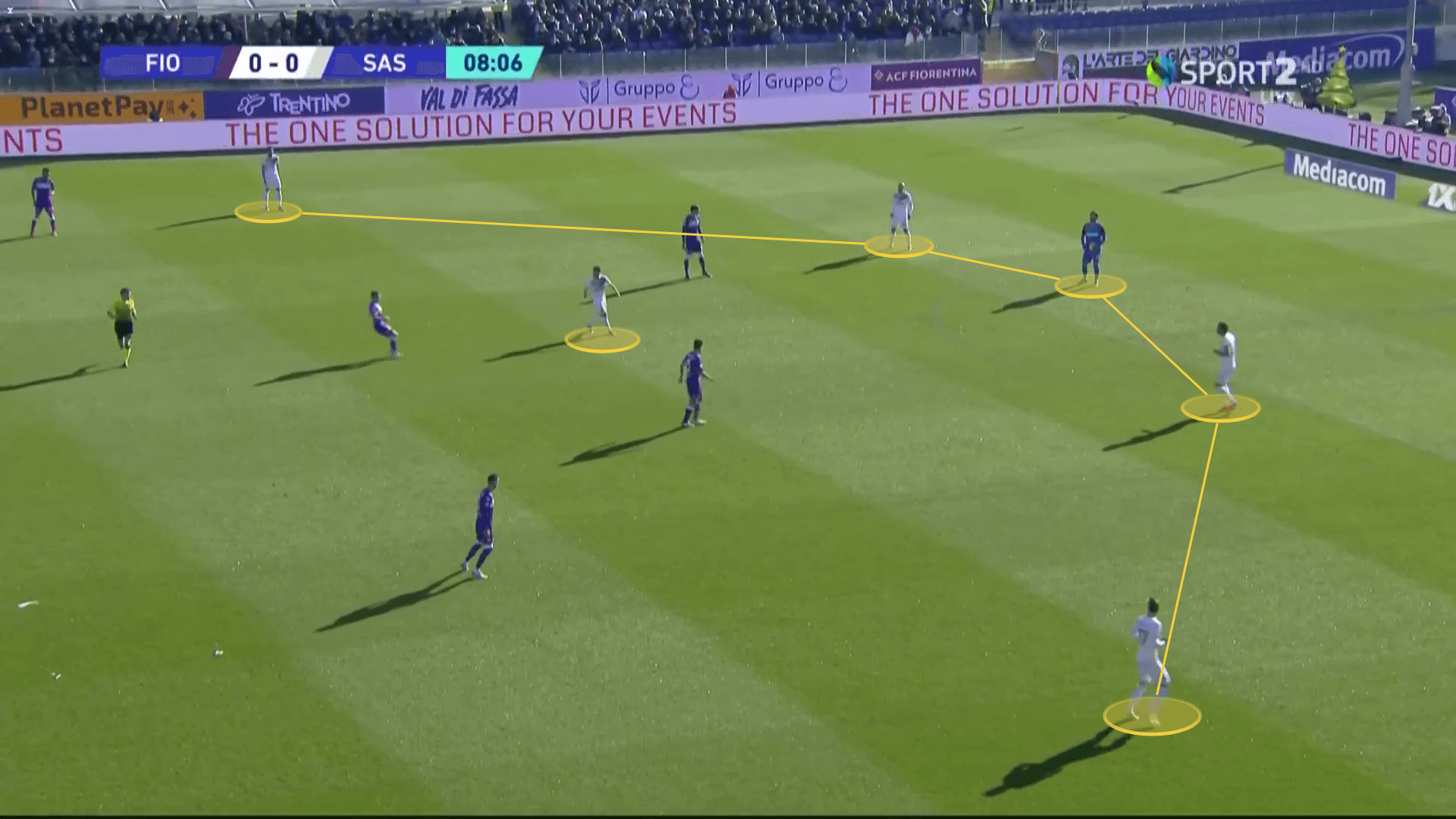
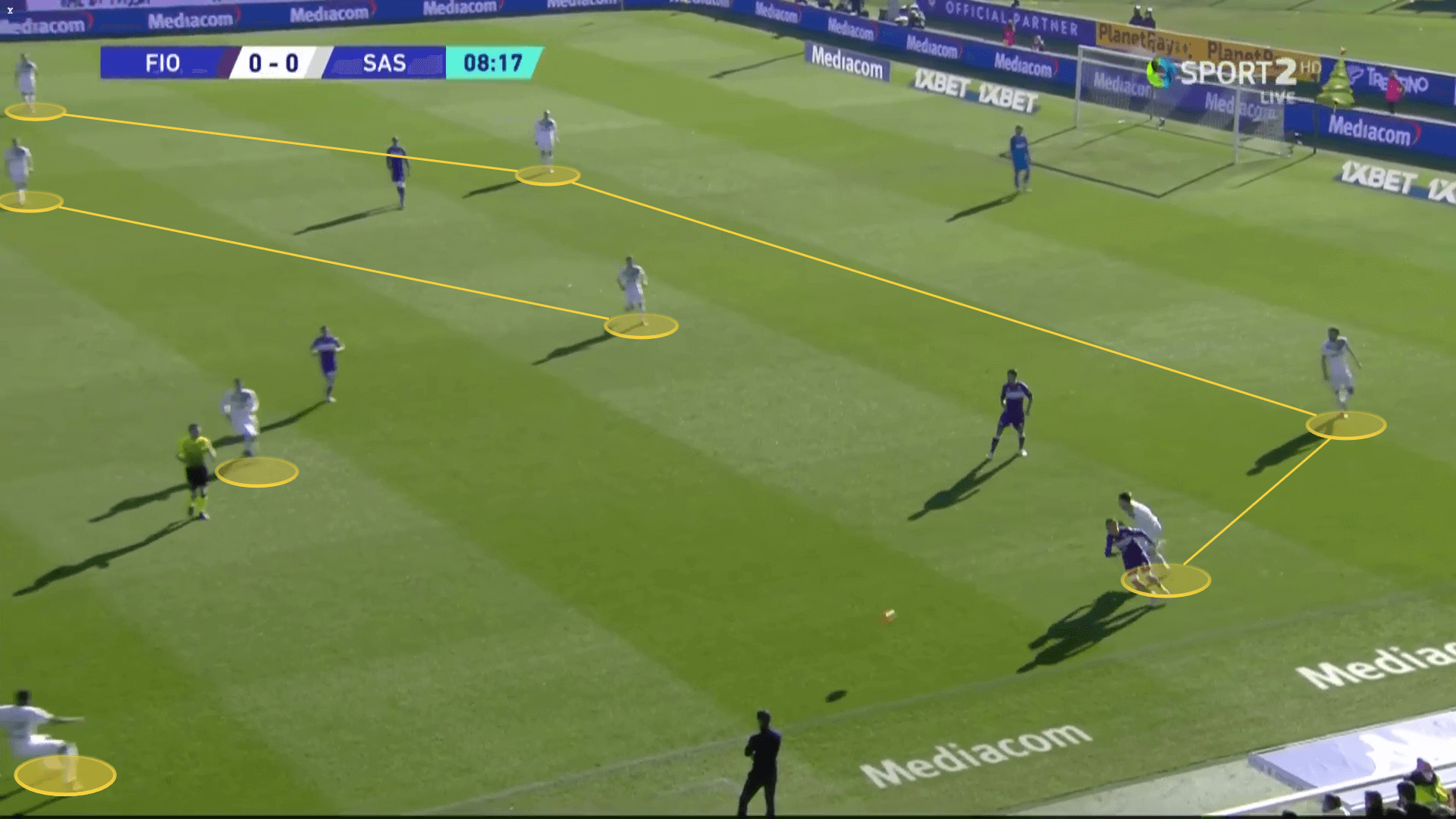
They don’t limit their movement to one area, as they try to build up both through the flanks and through the central areas, depending on the opportunity and their opponents’ movement. No matter which channel do they choose, they always progress the ball with high pass frequency, and what makes them successful is their pass completion of 87.5%, placing them in the top five in the league in terms of accuracy.
Their tendency to retain possession through short passing often leads to them dominating possession (56.85% on avg) and dictating the play. That gives them the chance to time their attacking movement well and expose the opposition successfully.
They rely on the players’ dribbling skills and ability to hold on to the ball to be able to progress it. The team are second in Serie A when it comes to the frequency of dribbling attempts, but even more important is their high success rate. The left attacking midfielder, Jeremie Boga, attempts to dribble past his opponents 9.44 times on average per game, placing him second in the league in that indicator. The individual skills of the players are important in Sassuolo’s strategy, as they often rely on their creativity to lead their way through.
Final third movement
While their short passing and link-up-play are key for delivering the ball to the final third, the team heavily rely on making progressive runs for breaking through defences and carrying the ball further. They average 17.37 progressive runs per game, the third’s highest number in the league.
The team’s attacking approach is balanced. The team don’t overcommit to certain movements but combine crossing with creating chances by using through balls and smart passes.
Dionisi involves quite a few attacking players, having Domenico Berardi and Gianluca Scamacca as the most regular starters on the right and centrally respectively.
The manager relies on overloading the final third and having many options in front of the goal. That’s why when the team move forward, they usually move as a unit and have almost all of the field players in the opposition half.
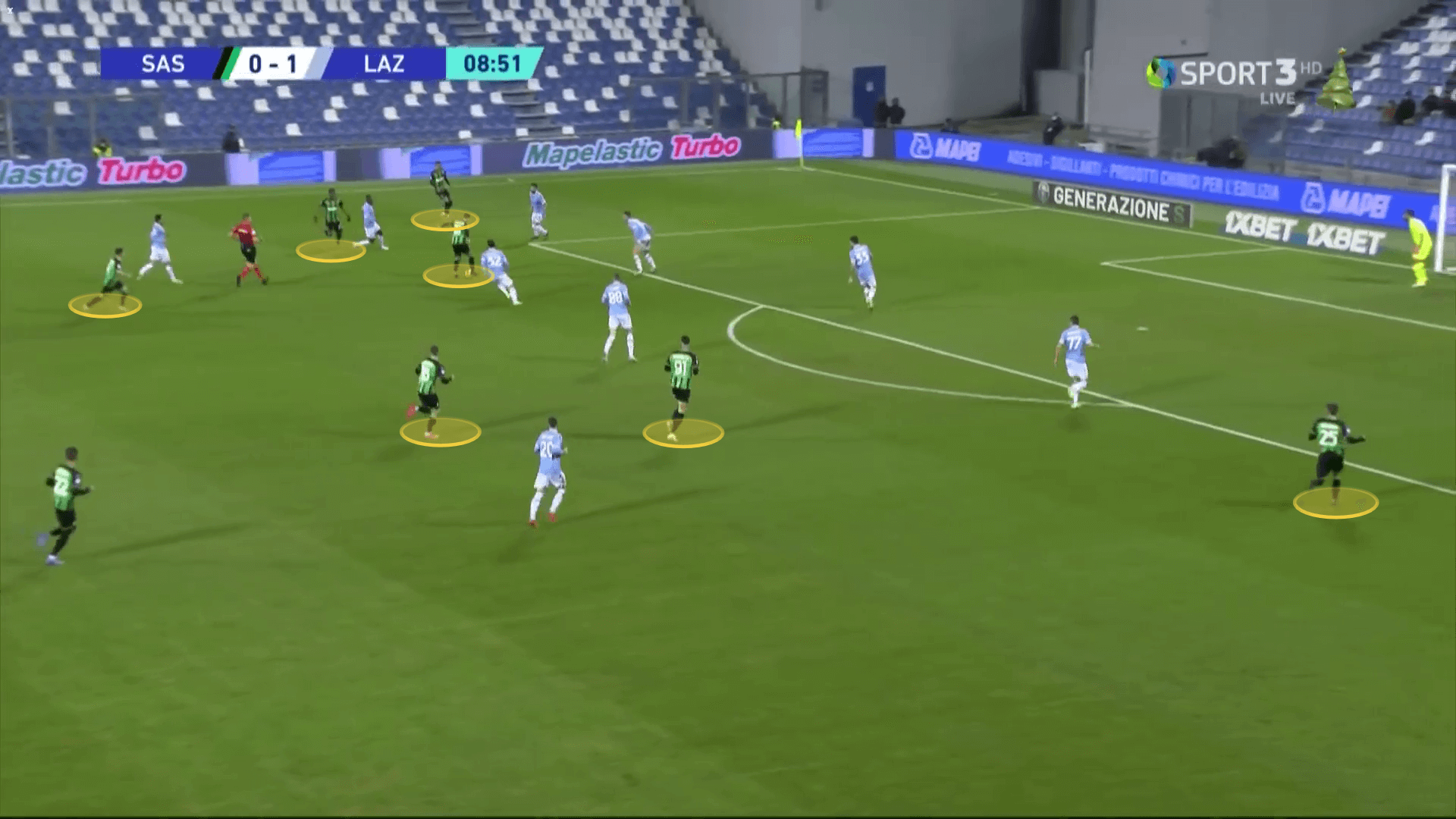
Sometimes, expectedly, the opposition blocks the passing lanes and structure well at the back, which forces Sassuolo to find solutions. That’s when they use positional interchanges and one-touch combinations to try and disposition the opposing players and expose the freed-up spaces. Whenever they cannot break through with their movement and short passing, they don’t hesitate to shoot from distance – 114/240 of Sassuolo’s total shots have come from outside the box, which makes roughly 47% of their efforts.
The team’s shooting frequency is higher than the average 11.3 shots per 90 in Serie A. Dionisi’s side produce 13.65 shots on average with an above-average accuracy, and at the time of writing, they have scored 30 goals, doing equally well in attack as José Mourinho’s Roma.
I Neroverdi are among those teams with the lowest average number of crossing attempts. While this is part of the team’s strategy, it has more to do with adjusting to their own limitations. They mostly rely on their full-backs to cross the ball, and while they are covered on the left with Rogério and Georgios Kyriakopoulos, the former Borussia Dortmund player Jeremy Toljan isn’t as active on the right. As we will explain later, Berardi prefers to cut inside instead of supplying the ball with crosses, which expectedly drops their numbers too.
The team also rely on exposing the opposition on a counter quite frequently. They complete 2.35 counter-attacks on average per game, thanks to their ball recovery efforts. I Neroverdi’s press in the opposition half is often successful, and they manage to create chances from these opportunities.
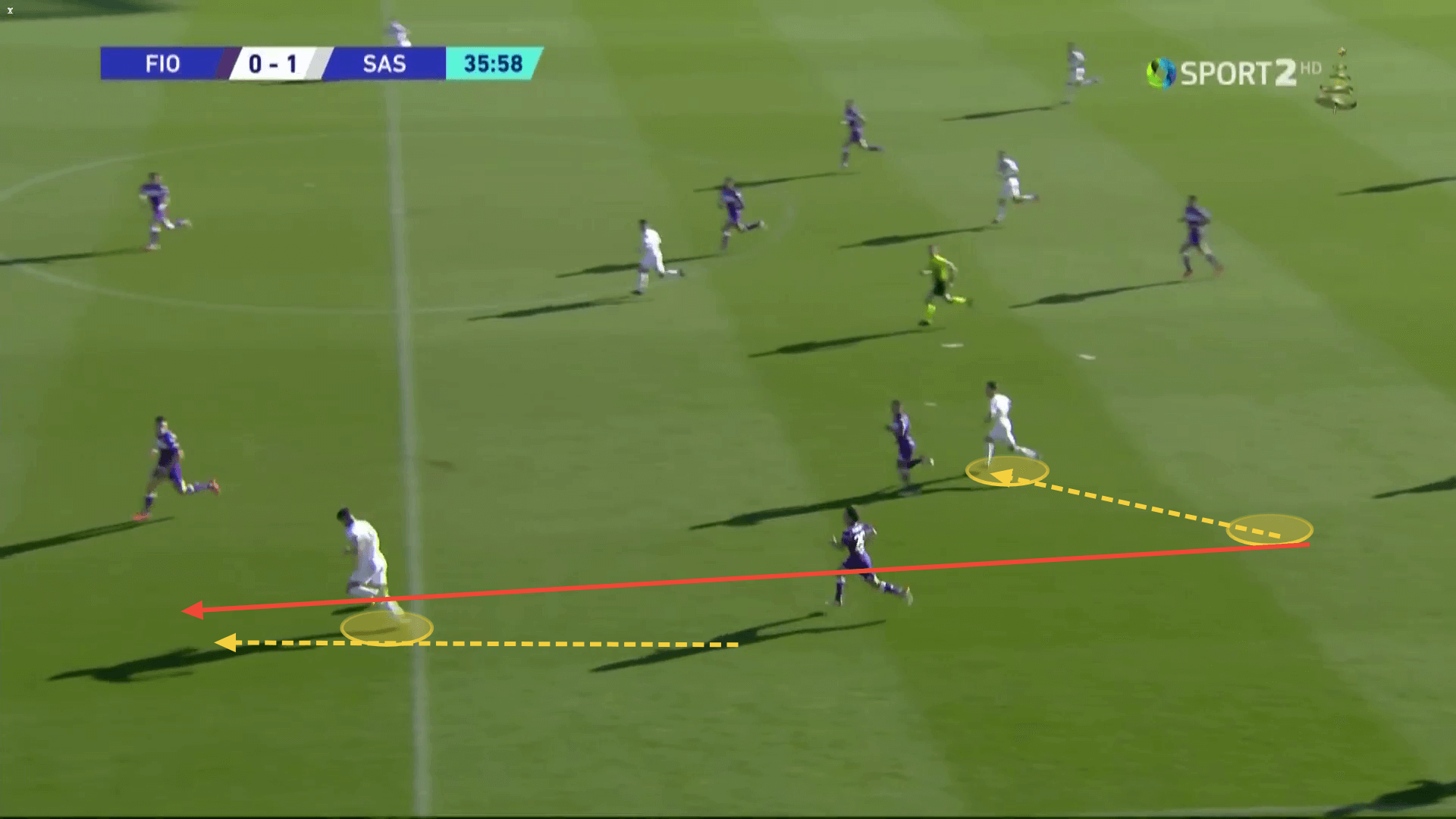
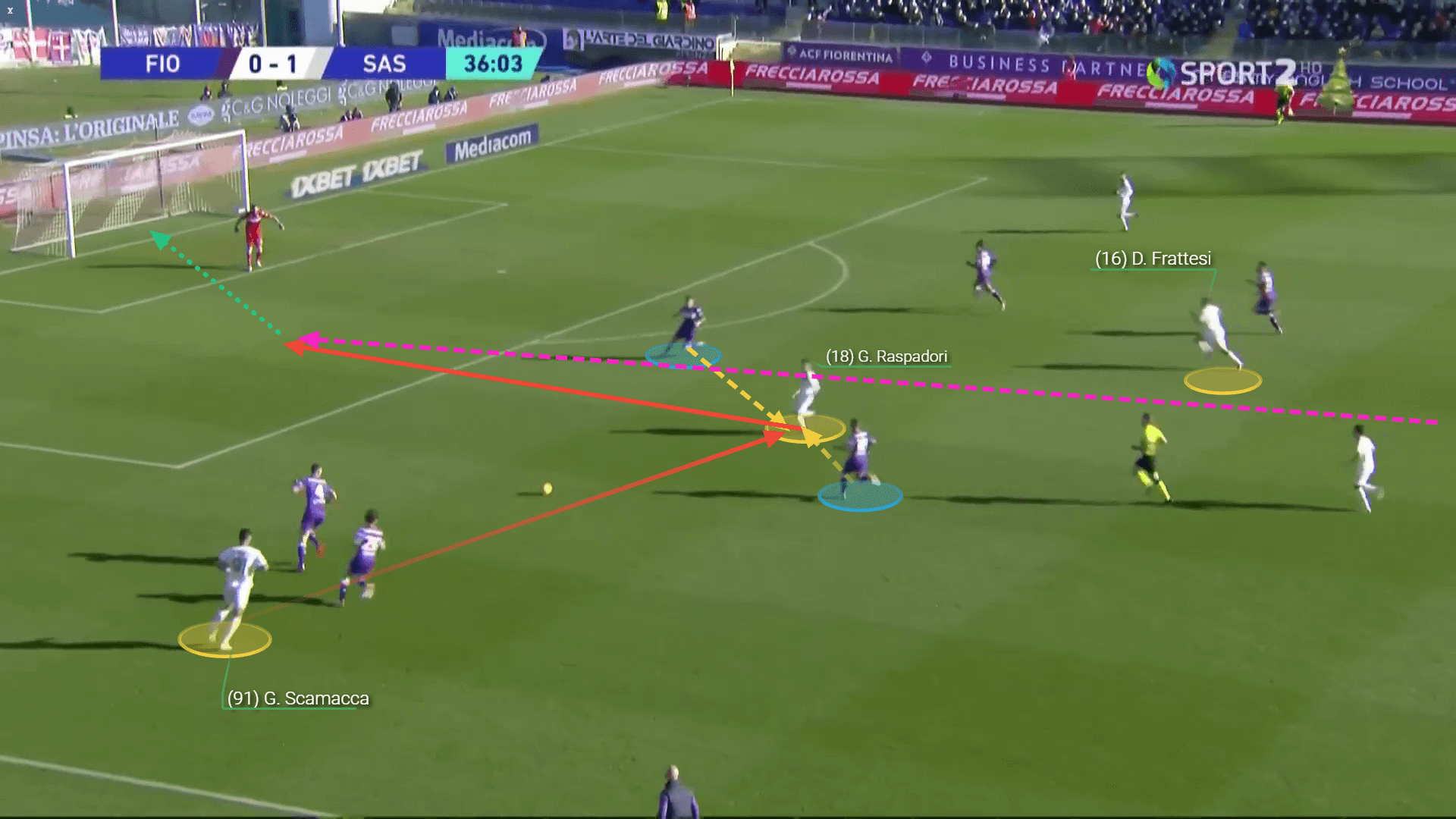
Even if they drop deeper and win the ball in their own half, their compactness allows them to quickly deliver it to the advanced areas, as they have many players that can finish off. They are successful thanks to their anticipation skills and off the ball movement.
Out of possession behaviour
Sassuolo have many defensive vulnerabilities, which is the main reason for their positioning in the middle of the table. It is the complexity of their problems that prevents them from grabbing points, despite their attacking efforts.
As mentioned, the team usually stay deeper and often invite the play in their own half. While that has some benefits in possession, it often turns against them whenever they need to defend. Their ball circulation between the central defence and the defensive midfield makes them prone to mistakes, as it gives their opponents the perfect opportunity to recover the ball in the advanced areas and expose them. Most of the team’s losses that have led to opposition shots are a result of losing the ball on the edge of the box centrally. They have conceded 16 goals from open play, and most of them as a result of losing possession in key areas due to their build-up from the back and tendency to circulate the ball there.
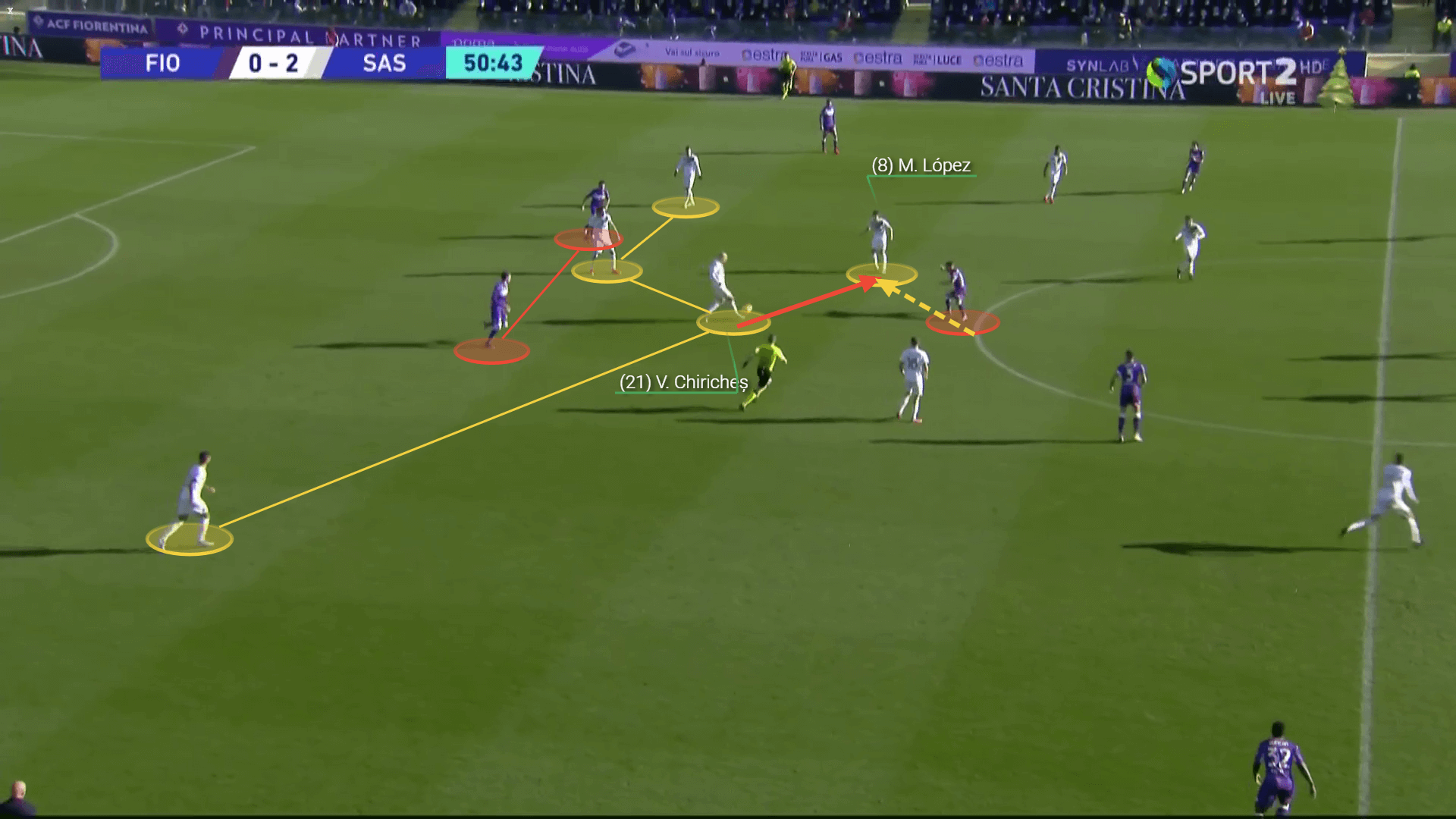
Another reason is the involvement of their attacking players in defence. While on paper, it sounds like some additional support would be great, it is more likely that these players don’t have the same work ethic and reactions under pressure, resulting in losing the ball or making fouls. An example of this is Berardi, who is often involved defensively but is also prone to committing fouls.
Sassuolo are amongst the team with the fewest ball losses on average per 90, but that number doesn’t show the full picture. While their build-up strategy of quick short passing guarantees them more security and pass accuracy, it also leads to losing the ball in more dangerous areas.
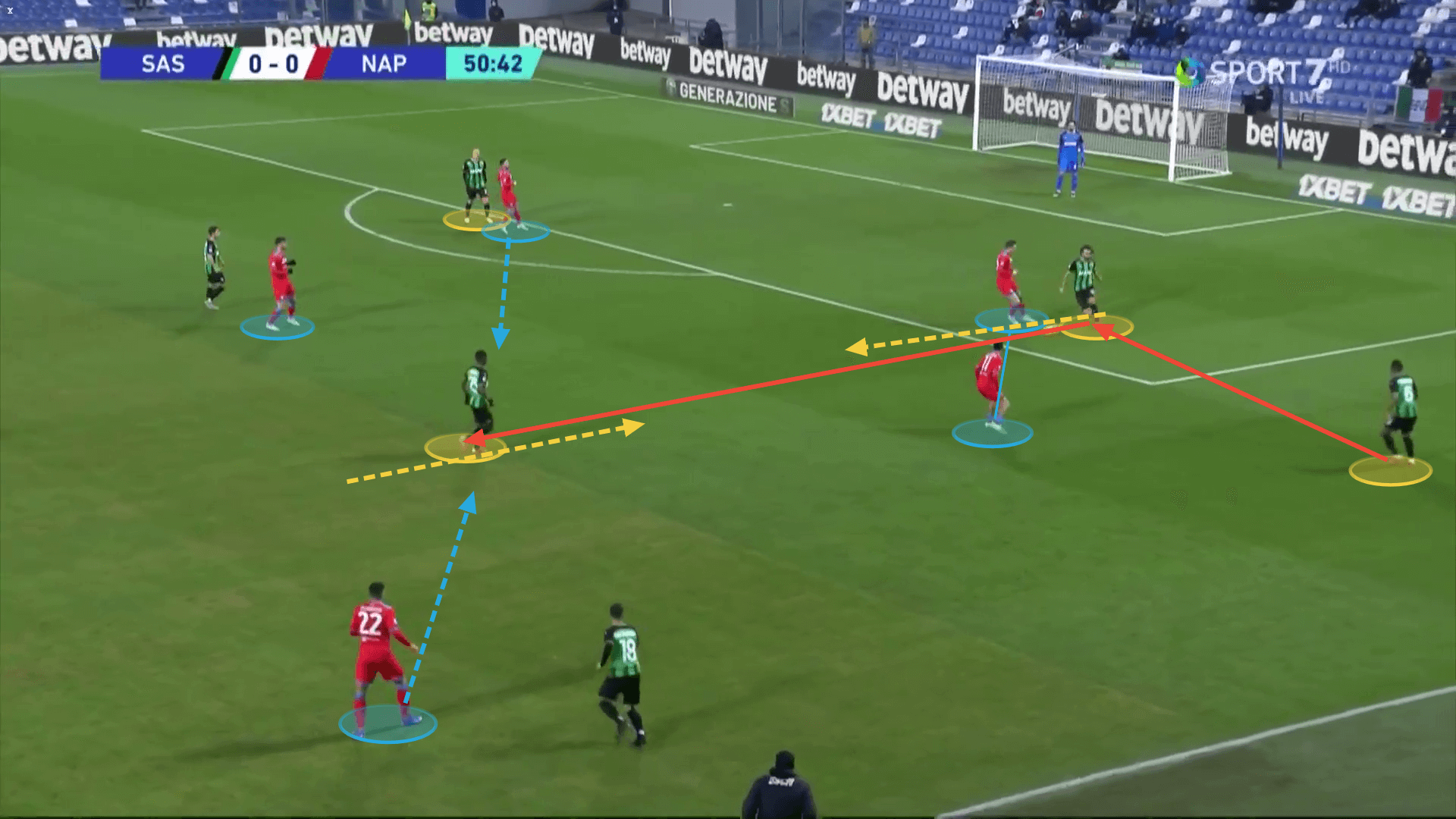
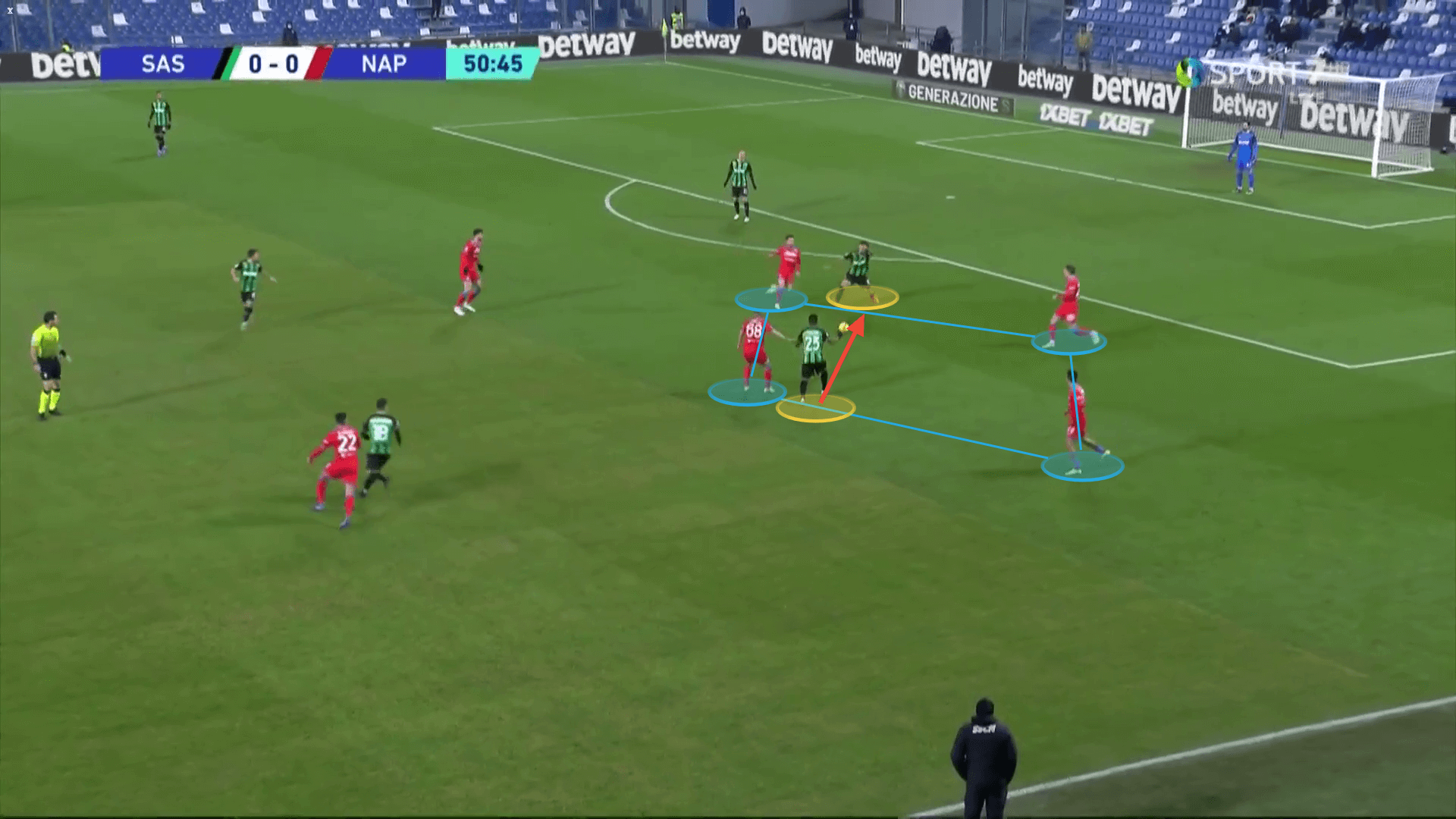
That leads to another problem. While they commit a low number of fouls on average, they often act hastily and commit them exactly in these dangerous areas. At the time of writing, I Neroverdi have conceded four goals from penalty shots, despite Sassuolo’s goalkeeper, Andrea Consigli, being the best penalty saver in Serie A this season, with four saved penalties. A total number of eight penalties called against the team underlines their struggles under pressure.
Their unmeasured actions can also result in giving away set-piece opportunities. That is another area where the team struggles. They have conceded five goals from set-plays, and the main reason for that is their unbalanced aerial performance. The team lose their aerials duels in the box rather often, which has resulted in conceding twice from corners, once from an indirect free-kick and twice from open play.
Key performer
Domenico Berardi is undoubtedly the key player in Sassuolo’s squad. While the midfielders also have crucial roles in their performance, Berardi is the main player to convert their efforts into goals.
At the time of writing, the Italian is not only the team’s leading goalscorer with eight goals but also the main creator for his teammates with six assists. Despite playing at the right wing, Berardi possesses a huge direct threat due to his tendency to cut inside.
He is successful in his movement thanks to his dribbling abilities, as he averages 4.79 dribbles per 90. This allows him to take on defenders and move into quality goalscoring positions. Whenever he is unable to break through the opposition’s defensive structures, he tends to shoot from outside the box, although he has been more efficient in shooting from a close distance. He produces 3.22 shots on average per game.
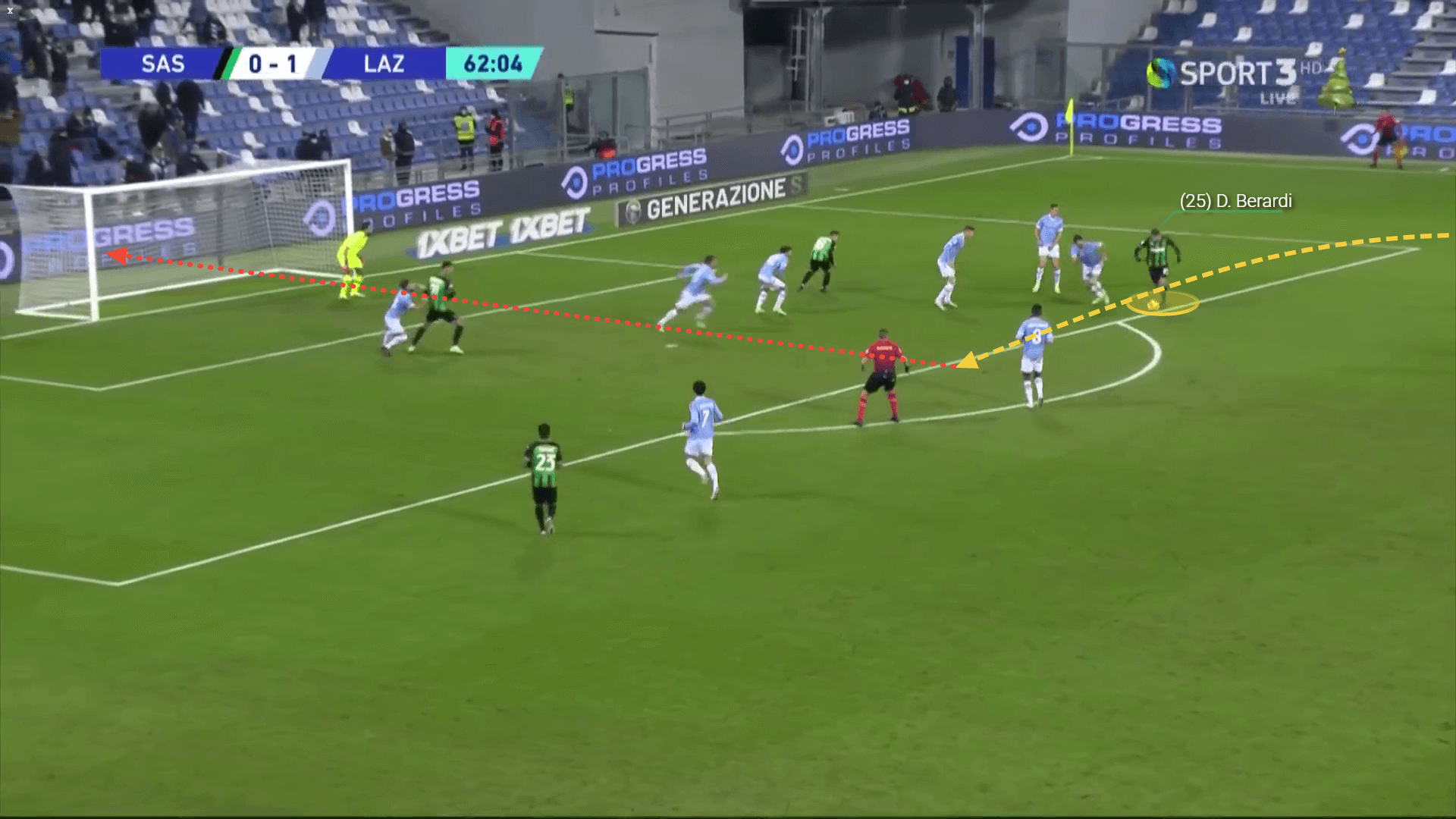
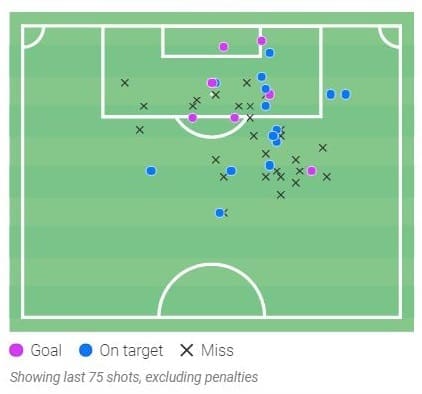
Despite his wide position, Berardi is more beneficial with his movement into the half-spaces and centrally, as his left footedness limits his crossing contribution from the right. His crossing accuracy though is very high (44.9%) and compensates for the low frequency.
His presence in the wide areas stretches defences, allowing him to cut inside and exploit spaces, but his movement also creates spaces for his teammates with quality balls.
Conclusion
As our analysis shows, the team’s possession-based approach and build-up methods are the key to their success and often the reason for their failure. While it gives them many opportunities in possession and helps them break through the press and expose their opponents, it also makes them prone to mistakes in dangerous areas.
The young coach Dionisi should reconsider their build-up strategy and analyse whether they should stop inviting the play in their own half and whether moving the team to a more advanced position would decrease the number of shots and goals that they concede.
Being flexible and learning from their mistakes would be key for the team in the second half of the season, as that tendency to fail to protect their lead will cost them many points.





Comments